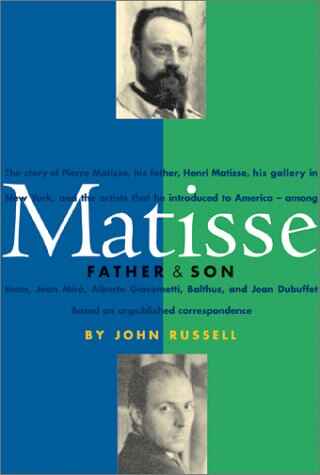
The former art critic of The Sunday Times (1949-74) and The New York Times (1974-1990), John Russell, in his book Matisse. Father & Son (Amazon.com, Amazon.co.uk, Amazon.de, Amazon.fr; allow Amazon cookies to go directly to the page) offers an account of the treasures hidden in the archives of Pierre Matisse (1900-89), art dealer and second son of painter Henri Matisse and his wife Amélie Parayre.
John Russell himself knew Pierre Matisse personally. In the art dealer’s archives he found over 800 letters exchanged between father and son — hence the title of his book. Some of the letters are over 20 pages long. Russel has not written another biography of Henri Matisse, but concentrates on his son. His study is not on the same brilliantly written and well-researched level as Hilary Spurling’s biography The Unknown Matisse, but he still has a lot to tell us.
In the early 1920s, as Pierre still aspired to become an artist, he informed his father in every detail about all of his works in progress and even sent him sketches of them. In late 1924, the son went to New York City where he started working for an art dealer. He toured around Europe looking for saleable art for the US-market. At the end of 1931, Pierre finally managed to establish his own gallery. Among his clients were soon famous people like actor Edward G. Robinson (1935), the king of the automobile industry Walter P. Chrysler (1935) as well as Joseph Pulitzer jr. (1936).
Russell has not written a detailed chronological biography. Instead, he included portraits of several giants of the 20th century art world represented by Pierre Matisse and his gallery. Among them, Juan Miró (1932), Alexander Calder (1934), Alberto Giacometti (1937), Balthus (1938) or Jean Dubuffet (1939).
In Pierre Matisse’s archives were not only family letters, but, for instance, also over 300 letters exchanged with Miró and almost 200 from Alberto Giacometti. Since Pierre was their art dealer, their letters are often about money. This may be disturbing and annoying for some purists, but these letters document the everyday struggle and the less glamourous side of the art world.
Joan Miró for instance only asked for regularly-paid modest sums. In exchange, he delivered a previously fixed quantity of paintings — always in time, as punctual as a Swiss watch and like an assembly line worker. His nature was in sharp contrast to the traditional romantic image of the artists as an unreliable person. Miró was in no way a dandy. At the same time, he was able to create works full of poetic charm.
John Russell’s book could sometimes benefit from being more analytical, but he still gives us some precious insights in the life of Miró, Giacometti, Balthus and Dubuffet. All these artists finally became famous and wealthy, as Pierre Matisse himself. He could enjoy the fruits of his success up to his death in 1989.
John Russell: Matisse. Father & Son, New York, Harry N. Abrams, 1999, 415 pages (Amazon.com, Amazon.co.uk, Amazon.de, Amazon.fr (allow Amazon cookies to go directly to the page).

For a better reading, quotations and partial quotations in this book review have not been put between quotation marks.
This book review was originally added to our pages on January 1, 2000. Book review added again (to our newly designed pages) on November 12, 2023 at 13:34 Swiss time. Originally, the article contained two reviews. The one about Hilary Spurling’ book The Unknown Matisse: A Life of Henri Matisse: the Early Years, 1868-1908 (Amazon.com, Amazon.co.uk, Amazon.fr, Amazon.de (accept cookies to go directly to the book page on Amazon) has now been published in a separate article.